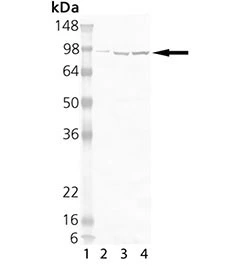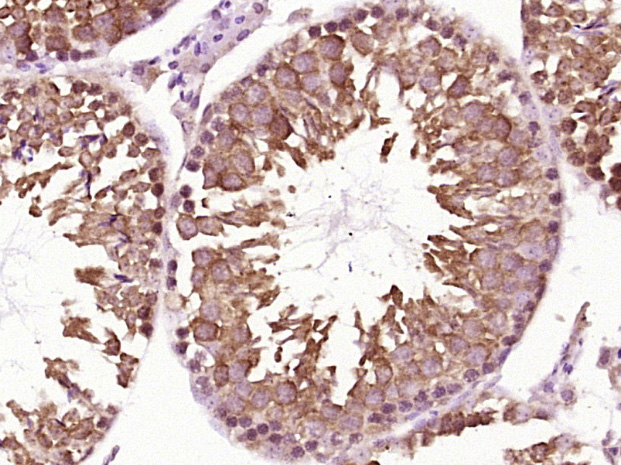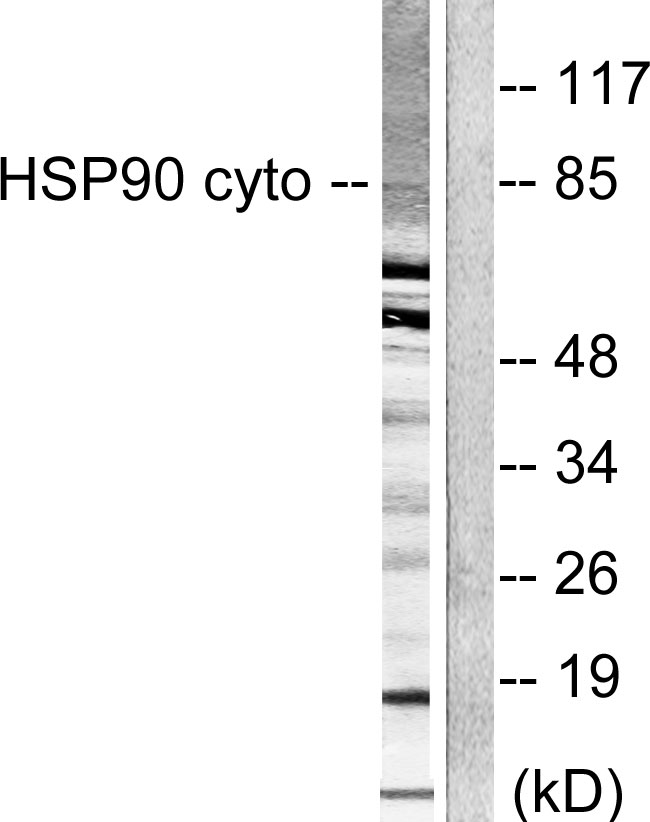
Western Blot analysis of HSP90 mAb (2D12). Lane 1: MW marker Lane 2: HSP90 (human) (native) Lane 3: HeLa HS, (cell lysate) Lane 4: Vero Heat Shock Cell Lysate
Hsp90 antibody [2D12]
GTX13480
ApplicationsImmunoPrecipitation, Western Blot
Product group Antibodies
TargetHSP90AA1
Overview
- SupplierGeneTex
- Product NameHsp90 antibody [2D12]
- Delivery Days Customer9
- Application Supplier NoteFor IP: Use at an assay dependent dilution. This antibody can be used for immunoprecipitation of free and complexed Hsp90. For WB: Use at a dilution of 1:500. Detects a band of approximately 90 kDa (predicted molecular weight: 84.7 kDa(alpha) and 83.2 kDa (beta)). Optimal dilutions/concentrations should be determined by the researcher.
- ApplicationsImmunoPrecipitation, Western Blot
- CertificationResearch Use Only
- ClonalityMonoclonal
- Clone ID2D12
- ConjugateUnconjugated
- Gene ID3320
- Target nameHSP90AA1
- Target descriptionheat shock protein 90 alpha family class A member 1
- Target synonymsEL52, HEL-S-65p, HSP86, HSP89A, HSP90A, HSP90N, HSPC1, HSPCA, HSPCAL1, HSPCAL4, HSPN, Hsp103, Hsp89, Hsp90, LAP-2, LAP2, heat shock protein HSP 90-alpha, HSP 86, LPS-associated protein 2, epididymis luminal secretory protein 52, epididymis secretory sperm binding protein Li 65p, heat shock 86 kDa, heat shock 90kD protein 1, alpha, heat shock 90kD protein 1, alpha-like 4, heat shock 90kD protein, alpha-like 4, heat shock 90kDa protein 1, alpha, heat shock protein 90kDa alpha (cytosolic), class A member 1, heat shock protein 90kDa alpha family class A member 1, heat shock protein family C member 1, lipopolysaccharide-associated protein 2, renal carcinoma antigen NY-REN-38
- HostRat
- IsotypeIgM
- Scientific DescriptionThe 90kDa molecular chaperone family comprises several proteins including the 90kDa heat shock protein, Hsp90 and the 94kDa glucose regulated protein, grp94 which are major molecular chaperones of the cytosol and of the endoplasmic reticulum. In mammalian cells there are at least two Hsp90 isoforms, Hsp90a and hsp90s which are encoded by separate genes. The amino acid sequence of human and yeast Hsp90a is 85% and 90% homologous to that of Hsp90s respectively. All known members of the Hsp90 protein family are highly conserved, especially in the N terminal and C terminal regions which have been shown to contain independent chaperone sites with different substrate specificity. These ubiquitous and highly conserved proteins account for 1-2% of all cellular proteins in most cells. Hsp90 is part of the cells powerful network of chaperones to fight the deleterious consequences of protein unfolding caused by nonphysiological conditions. However, in the absence of stress, Hsp90 is a necessary component of fundamental cellular processes such as hormone signaling and cell cycle control. In this context several key regulatory proteins such as steriod receptors, cell cycle kinases involved in signal transduction and p53 have been identified as substrates of Hsp90. It has been suggested that Hsp90 acts as a capacitor for morphological evolution by buffering widespread variation, which may affect morphogenic pathways.
- Storage Instruction-20°C or -80°C,2°C to 8°C
- UNSPSC12352203




![WB analysis of Hsp90 alpha and beta protein using GTX80037 Hsp90 antibody [MBH90AB].](https://www.genetex.com/upload/website/prouct_img/normal/GTX80037/GTX80037_20191028_WB_1_w_23061322_210.webp)
![WB analysis of various cell lines using GTX84343 Hsp90 alpha antibody [3B5]. Loading : 10 ug per lane Dilution : 1:200](https://www.genetex.com/upload/website/prouct_img/normal/GTX84343/GTX84343_3524_WB_w_23061420_765.webp)
![IHC-P analysis of human colon carcicnoma tissue using GTX33995 Hsp90 alpha antibody [1F6]. Dilution : 1:200](https://www.genetex.com/upload/website/prouct_img/normal/GTX33995/GTX33995_20200622_IHC-P_296_w_23060801_795.webp)
![IHC-P analysis of human colon carcicnoma tissue using GTX33996 Hsp90 alpha antibody [7D6]. Dilution : 1:200](https://www.genetex.com/upload/website/prouct_img/normal/GTX33996/GTX33996_20200622_IHC-P_297_w_23060801_563.webp)